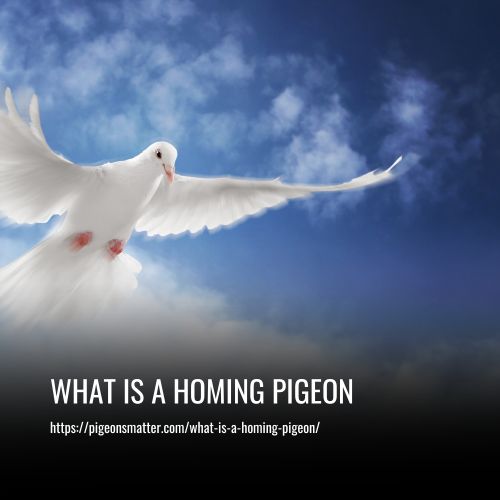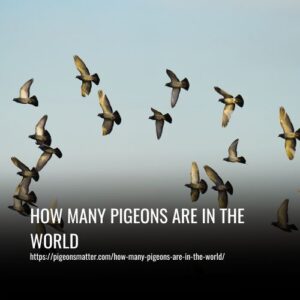A homing pigeon is a type of pigeon that has a natural instinct to find its way back home. It is a domestic pigeon that is bred specifically for its ability to return home from long distances and at high speeds. These pigeons were originally used for message delivery, but they are not the same as carrier pigeons. Homing pigeons can fly up to 60 mph and cover over 1000 km in a single flight. They are often used in pigeon racing competitions.

Types Of Homing Pigeons
There are two types of homing pigeons: homers and racers. Homers are regular domestic pigeons, while racers are homers that have been trained for pigeon racing shows. Both varieties are commonly used and valued for their homing instinct and ability to find their way back home.
Brief History Of Homing Pigeons
Homing pigeons have played a crucial role as messengers since ancient times, showcasing their remarkable navigation abilities. They possess a compass mechanism and a mysterious map mechanism, allowing them to navigate and cover long distances swiftly.
In addition to their role as messengers, homing pigeons are also used in racing and contests, where their speed and stamina are displayed. These competitions highlight the unique qualities of these birds and set impressive records.
Homing pigeons come in various sizes, colors, body types, and weights, making them adaptable to different climates and suitable as pets for those who appreciate their special features. However, concerns have been raised about pigeon racing and betting, as they raise worries about animal exploitation and welfare.
Unfortunately, homing pigeons have also been utilized for smuggling due to their exceptional navigation skills. Although this demonstrates their intelligence and ingenuity, it also raises ethical concerns regarding their involvement in illegal activities.
How To Identify Homing Pigeons
When observing pigeons, it’s important to note the unique characteristics of homing pigeons. These traits distinguish them from other pigeon species:
1. Round and Thin Body
Homing pigeons have a round and thin body shape, which sets them apart from other pigeon species. This body shape aids in their ability to fly long distances.
2. Round and Erect Head
Their heads are round and erect, proportionate to their body size. This distinct head shape assists in their navigational abilities.
3. Broad Chest
Homing pigeons have a broad chest, allowing for efficient flight and stamina during long-distance trips.
4. Iridescent Collar Coat
One of the notable physical features of homing pigeons is their iridescent collar coat. This shimmering plumage adds to their overall appearance.
5. Thin and Short Neck
Compared to other pigeon species, homing pigeons have a thin and short neck. This neck structure contributes to their streamlined flight capabilities.
6. Different Coat Hues
Homing pigeons display a variety of coat hues depending on their type. These colors can range from light to dark, providing further differentiation among individual birds.
7. Different Eye Colors
Homing pigeons exhibit various eye colors, including gray, brown, orange, yellow, and red. The eye color can vary within the species and may contribute to their unique appearance.
In addition to these physical traits, it’s common for homing pigeons to have identification bands attached to their legs. These bands typically contain numbers that help identify and locate their owners.
How To Train A Homing Pigeon
Training homing pigeons requires patience and careful planning. Here are some steps to follow:
1. Start Early: Begin training your homing pigeon when it is around 6 weeks old. At this age, they can learn to find their way back to the loft after being released.
2. Gradual Distance: When releasing the pigeons for training, avoid taking them too far from their loft all at once. Training should be done slowly and steadily, increasing the distance gradually over time.
3. Establish Base Location: Set the home loft as the base location for the pigeons. This loft should have a trap door that allows them to enter but prevents them from leaving. Choose an alternate location as well, which will become the second base for their flights.
4. Create Comfortable Lofts: Ensure that both the home loft and the alternate loft provide all the necessary facilities for the pigeons. This includes access to water, sufficient food, and protection from predators. This will motivate the pigeons to return to their starting point.
5. Timing and Distance: As training progresses, gradually increase the flying distance between the two locations. Increase the releasing distance by approximately 5 miles per week. It’s also beneficial to release the birds in multiple directions and observe their behavior for signs of distress or wandering.
6. Bird Loss Prevention: Losing birds during training is common, but it’s important to be patient. Some pigeons may become tired and require downtime. If you experience frequent bird losses, consider reducing the training sessions on distance and time.
By following these steps and being patient and persistent, you can successfully train your homing pigeons to navigate between two locations.
How To Breed Homing Pigeons
Breeding homing pigeons requires careful planning and attention to detail. Here are some steps to follow to ensure a successful breeding process:
1. Check the pigeons’ health: Consult with a veterinarian in late October or early November to ensure that the pigeons are in good health and ready for breeding.
2. Maintain a clean loft: Keep the loft tidy and well-maintained to provide a comfortable environment for the breeding pair.
3. Feed a special breeding mixture: Start feeding the pigeons a special breeding mixture that provides the necessary nutrients for successful breeding. Consult with a veterinarian to determine the right feeding regimen for your pigeons.
4. Pre-couple the breeding pair: Allow the pigeons to stay together and get accustomed to each other by pre-coupling them. This helps establish a bond between the pair and prepares them for breeding.
5. Provide privacy: Keep the breeding pigeons away from curious eyes to give them privacy and allow them time to rest. This helps create a calm and conducive environment for breeding.
6. Nest box preparation: Prior to laying, leave the pair in their nest box for a few days to allow them to adapt and prepare for breeding.
By following these steps and providing proper care and attention, you can increase the chances of successful breeding in homing pigeons.
How To Raise Homing Pigeons
Homing pigeons played a crucial role in carrying messages across enemy lines during World War I and II, earning them recognition for their bravery. It should be noted that 32 of these birds have received The Dickin Medal, which is the most prestigious award for bravery given to animals.
Today, homing pigeons are commonly known as “racing pigeons” or “racing homers.” In the United States, there are clubs dedicated to raising and breeding racing homers for their enhanced speed and homing instincts. The birds undergo training and conditioning by club members for racing distances between 100 to 600 miles. Upon their return, the birds are timed and judged based on their speed and accuracy in finding their way back home.
Through the continued breeding and training of racing homers, these birds have become a beloved and respected part of the racing community. Their impressive abilities and loyalty have made them a symbol of determination and perseverance, both on and off the battlefield.
How To Feed Homing Pigeons
Proper nutrition is essential for the health and well-being of homing pigeons. Here are some guidelines on how to feed them:
1. Balanced Mixture of Seeds and Grains
Homing pigeons require a diet that consists of a balanced mixture of seeds and grains. This provides them with the necessary nutrients for their overall health. Make sure to choose high-quality seeds and grains to ensure your pigeons get the right nutrition.
2. Specific Diet Formulations
There are diet formulations available for different purposes, such as breeding, resting, and performance. If your homing pigeon is being trained for racing sports, it’s important to provide a diet that includes protein (12-14%), fat (7-15%), and carbohydrates.
3. Additional Foods
You can supplement your homing pigeons’ diet with the following foods:
Pelletized Food: Pellets specifically formulated for pigeons can be included in their diet. These pellets provide a balanced mix of nutrients and can be a convenient option.
Veggies and Fruits: Fresh vegetables and fruits are a good source of vitamins and minerals. Offer a variety of leafy greens, carrots, peas, apples, and berries to provide a diverse diet.
Moderate to Minimal Dairy Consumption: While birds are typically lactose intolerant, some homing pigeons may tolerate minimal amounts of dairy products. However, it’s best to offer dairy products sparingly and monitor your pigeons’ tolerance.
Avoid Harmful Foods: Do not feed your pigeons junk food, salty foods, chocolates, or beverages with caffeine or alcohol. These foods can be toxic to birds and should be avoided.
Remember to provide clean and fresh water at all times for your homing pigeons. Additionally, observe your birds closely and adjust their diet as needed to ensure they are healthy and thriving.
How Do Homing Pigeons Find Their Way Home
Homing pigeons have a remarkable ability to navigate back to their nest, and they primarily rely on magnetoreception. While the exact mechanism is not fully understood, there are two main theories proposed by scientists.
The first theory suggests that pigeons have magnetic material inside them that helps them detect the Earth’s magnetic field. This internal compass allows them to orient themselves and find their way home.
The second theory is based on a “free-radical pair” mechanism, which relies on the interaction between light and molecules in the bird’s eyes. This mechanism may enable pigeons to see and interpret the Earth’s magnetic field as a visual cue, assisting in their navigation.
Researchers are also studying a specific structure called “cuticulosomes” found in the ears of pigeons. These cuticulosomes contain iron particles, and scientists are investigating whether they play a role in magnetoreception. However, conclusive findings are still a long way off, and further research is needed to understand the exact mechanisms behind how homing pigeons find their way home.
Homing Pigeon Characteristics & Uses
Homing pigeons are a breed of domesticated pigeons known for their innate homing ability. These birds can find their way back to their nest using magnetoreception and have been selectively bred for their ability to find their home over extremely long distances.
Competitive pigeon racing has recorded flights as long as 1,100 miles by these birds, and they can fly at an average speed of 50 mph over moderate distances. Top racers have been observed to fly at speeds of up to 90 mph for short distances.
Homing pigeons were historically used as messenger pigeons, often referred to as “pigeon post” or “war pigeons” during times of war. They are an ancient breed of domesticated pigeons and were even used to proclaim the winner of the Olympics over 3,000 years ago.
Today, homing pigeons are still entered into competitions and can vary in size, color, body type, and weight depending on the type of bird. However, their use as messenger pigeons has declined due to the expansion of the internet, and they are now mainly used for recreational purposes.
| Breed Name | Homing |
| Other Name | None |
| Breed Purpose | Can vary depending on the variety |
| Special Notes | Beautiful birds, strong and hardy |
| Breed Class | Vary |
| Weight | Depends on the variety |
| Climate Tolerance | All climates |
| Flying Ability | Excellent |
| As Pets | Good |
| Color | Many, depend on the variety |
| Rarity | Common |
| Country/Place of Origin | Depends on the variety |
FAQs
Homing pigeons can fly up to 60 mph and cover over 1000 km in a single flight. The actual distance they can cover depends on factors such as weather conditions, the pigeon’s training, and its level of experience.
Yes, homing pigeons can be kept as pets. However, it is important to provide them with proper care. This includes a spacious and secure loft for them to live in, a balanced diet to ensure their nutritional needs are met, clean water for them to drink, and regular health check-ups to monitor their well-being.
The average lifespan of a homing pigeon is typically around 6 to 8 years. However, it’s important to note that this lifespan can vary depending on factors such as how well they are cared for, their diet, and the conditions they live in.
Homing pigeons played a crucial role in both World War I and World War II. They were used to carry important messages across enemy lines, helping to coordinate military efforts and potentially saving lives. In fact, some pigeons were even awarded medals for their brave and valuable service during the wars.
Conclusion
Homing pigeons are truly remarkable creatures that have been used for centuries for their incredible ability to navigate and find their way home. Whether you’re a pigeon enthusiast or just fascinated by these winged wonders, there’s no denying that homing pigeons is a true testament to the incredible power of nature.
So, the next time you see a pigeon flying by, take a moment to appreciate the incredible journey they’re on and the amazing skills they possess.


